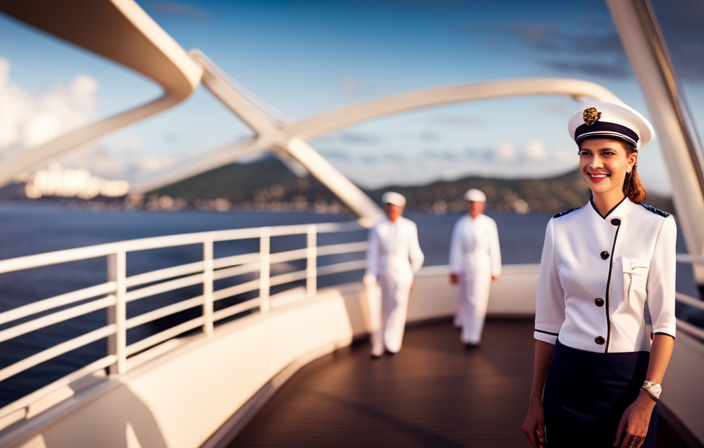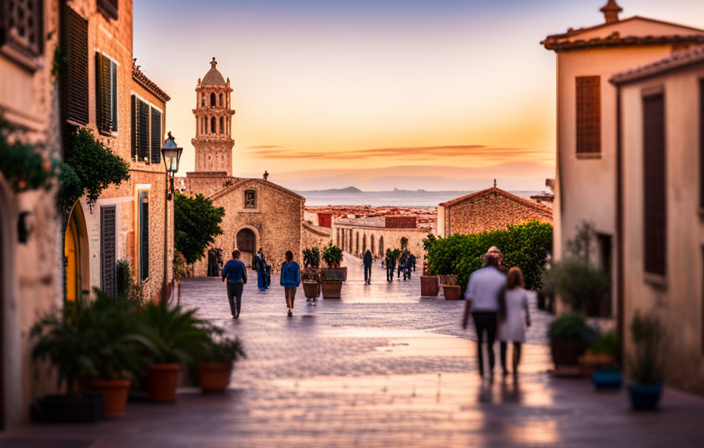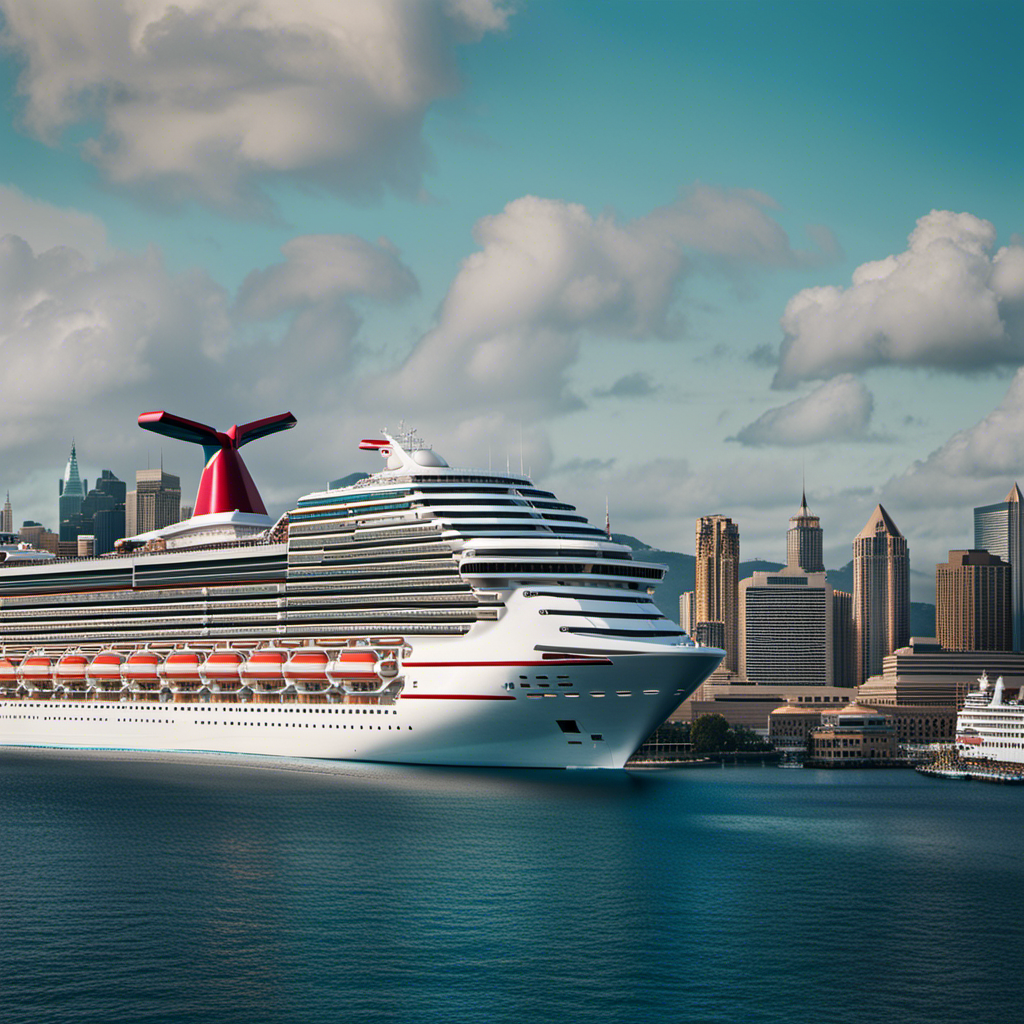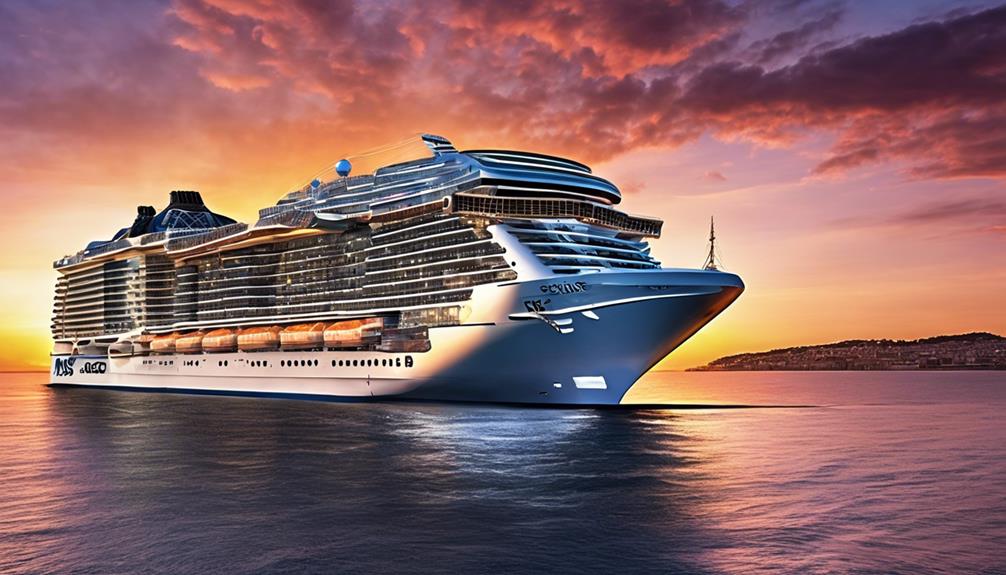Have you ever wanted to see a cruise ship without it being surrounded by water? The view is truly amazing and never ceases to amaze me.
As I stand here, gazing at the massive structure towering above me, I can’t help but feel a mix of awe and curiosity. The intricate design and engineering that go into creating these floating giants are truly remarkable.
Countless windows and decks stretch across the ship, revealing hidden details that are often overlooked by passengers. But it’s not just the exterior that captivates me; it’s also the machinery and equipment hidden within that keep these vessels running smoothly.
From the maintenance and repairs to the dry docking process, there’s so much more to these ships than meets the eye.
Join me on this journey as we explore what a cruise ship really looks like out of water, and discover a whole new perspective on these extraordinary vessels.
Key Takeaways
- Cruise ships are massive in size, with heights equivalent to a ten-story building and lengths exceeding 1,000 feet. They can accommodate thousands of passengers and crew members, but there are concerns about their environmental impact.
- The design and engineering of a cruise ship require meticulous attention to detail. The use of reinforced steel, support beams, and bulkheads ensures structural stability and allows safe navigation in various weather conditions.
- Cruise ships have a towering structure with a network of steel beams and supports to ensure stability. They feature various decks, cabins, lengths, and heights, showcasing their engineering marvel. These ships are designed to withstand the forces of nature and provide a luxurious experience for passengers.
- The construction of a cruise ship involves strategic placement of windows for panoramic views and decks positioned for outdoor activities and lounging. The integration of windows and decks into the structure enhances the ship’s aesthetic appeal and functionality. Additionally, hidden details are revealed, showcasing remarkable craftsmanship and attention to detail.
The Massive Size of a Cruise Ship
When you see a cruise ship out of water, you’ll be amazed by its colossal size. These floating giants are a testament to unique architecture and engineering. The sheer magnitude of a cruise ship is mind-boggling.
With multiple decks towering above the waterline, they can reach heights equivalent to a ten-story building. Their length can exceed 1,000 feet, accommodating thousands of passengers and crew members.
However, this grandeur comes at a cost. The impact on the marine environment is a significant concern. The massive size of cruise ships can disrupt the delicate balance of marine ecosystems, affecting fish populations and coral reefs. It is essential for the industry to prioritize sustainable practices to mitigate these effects.
Transitioning into the subsequent section, the intricate design and engineering of these vessels is equally impressive.
The Intricate Design and Engineering
Crafted with meticulous attention to detail, the elegant and elaborate structure of a cruise ship showcases the culmination of intricate design and engineering expertise. Design innovation is at the heart of every aspect of a cruise ship’s construction. From the sleek exterior lines to the carefully planned interior spaces, every element is carefully considered to create a visually stunning and functional vessel.
Structural stability is another key feature of a cruise ship’s design. The ship’s hull is specifically designed to withstand the forces of the open ocean, with reinforced steel and advanced engineering techniques ensuring its strength and durability. The intricate network of support beams and bulkheads further enhances the ship’s stability, allowing it to safely navigate through various weather conditions.
As we transition to the subsequent section about the towering structure, we can appreciate how the design and engineering work together to create a remarkable feat of maritime architecture.
The Towering Structure
Take a moment to imagine yourself standing in awe of the towering structure that rises above you, reaching towards the sky with its majestic presence. The architecture of a cruise ship is a true engineering marvel, designed to withstand the forces of nature while providing a luxurious experience for its passengers. The massive size of these vessels is made possible by a complex network of steel beams and supports that distribute the weight evenly, ensuring stability. A 3 column and 5 row table can help illustrate the intricate design elements, showcasing the various decks, the number of cabins, and the overall length and height of the ship. This table not only provides a visual representation but also conveys the scale and grandeur of these floating cities. Transitioning to the subsequent section, the countless windows and decks offer panoramic views and endless opportunities for relaxation and entertainment.
Countless Windows and Decks
Passengers aboard the cruise ship are treated to breathtaking views and endless opportunities for relaxation and entertainment, thanks to the countless windows and decks. The architecture of a cruise ship is meticulously designed to maximize the passenger experience. Each window is strategically placed to allow for panoramic views of the surrounding seascape. The decks, on the other hand, are carefully positioned to provide ample space for outdoor activities and lounging.
The construction process of a cruise ship involves intricate planning and engineering. The ship is built using a combination of steel and other materials to ensure stability and safety. The windows and decks are integrated into the structure, enhancing the ship’s aesthetic appeal and functionality.
As we explore further into the hidden details revealed, we will discover the remarkable craftsmanship and attention to detail that goes into creating these floating marvels.
Hidden Details Revealed
You’ll be amazed to learn that every square inch of a cruise ship is meticulously designed, including hidden details that add to the overall experience. One of these hidden details is the presence of hidden compartments throughout the ship. These compartments serve various purposes, from storing emergency supplies to housing important equipment. They are strategically placed to maximize space and efficiency, ensuring that everything is easily accessible when needed.
Additionally, the underwater architecture of a cruise ship is an engineering marvel. The ship’s hull is specially designed to withstand the pressure of the water and provide stability. It is also designed to reduce drag, allowing the ship to move smoothly through the water.
These hidden compartments and underwater architecture are just a glimpse into the intricate inner workings of the ship, which will be explored in the subsequent section about the inner workings of the ship.
The Inner Workings of the Ship
The inner workings of a cruise ship are like a complex labyrinth, with a network of pipes, wires, and machinery intertwining throughout the vessel. To fully appreciate the intricacies of a cruise ship, consider the following:
-
Cruise ship propulsion: A cruise ship relies on powerful engines to propel itself through the water. These engines are often powered by diesel or gas turbines, which convert fuel into mechanical energy.
-
Electrical systems: A cruise ship requires an extensive electrical network to power its various systems and amenities. This includes lighting, air conditioning, entertainment systems, and navigation equipment. Massive generators produce the electricity needed to keep everything running smoothly.
-
Water systems: Cruise ships have intricate plumbing systems that supply fresh water to various areas onboard, such as cabins, restaurants, and spas. Waste management systems ensure that sewage and other waste are properly disposed of.
-
Safety systems: Cruise ships are equipped with advanced safety systems, including fire detection and suppression systems, emergency power backup, and life-saving equipment.
Understanding the inner workings of a cruise ship is crucial for maintaining its smooth operation and ensuring the comfort and safety of its passengers.
Transitioning into the subsequent section about ‘the machinery and equipment’, we delve further into the fascinating components that power this floating city.
The Machinery and Equipment
Get ready to dive deep into the intricate machinery and equipment that make a cruise ship a floating city, as you explore the inner workings of this majestic vessel. The machinery and equipment on a cruise ship are essential for its operation and require regular maintenance to ensure smooth sailing. The ship’s propulsion system, which typically consists of diesel engines and electric motors, powers the ship through the water. Additionally, there are generators that produce electricity for various functions onboard. Other equipment includes HVAC systems for climate control, water desalination plants for freshwater supply, and waste treatment systems to manage sewage and garbage. Constant machinery maintenance and equipment operation are crucial to keep the ship running smoothly and providing a comfortable experience for passengers. Transitioning into the next section about maintenance and repairs, it is important to understand the significance of regular upkeep to keep the ship at its best.
Maintenance and Repairs
During my exploration of the machinery and equipment found on a cruise ship, I discovered the importance of maintenance and repairs. This current subtopic delves deeper into the necessary measures taken to ensure the ship’s optimal performance.
One such procedure is underwater inspections, which involve sending divers down to examine the hull and other submerged areas for damage or corrosion. This enables us to identify any potential issues early on and take appropriate action.
Additionally, regular hull cleaning is crucial to prevent the build-up of marine growth, which can negatively impact the ship’s speed and fuel efficiency. It involves removing biofouling and other debris from the hull’s surface, ensuring smooth sailing.
These meticulous procedures are fundamental in maintaining the ship’s integrity and efficiency.
Transitioning into the subsequent section on the dry docking process, let’s now explore how it further contributes to the ship’s overall maintenance.
Dry Docking Process
Exploring the intricacies of maintaining a cruise ship, let’s now delve into the fascinating process of dry docking and how it contributes to the ship’s overall maintenance and longevity.
Dry docking procedures are crucial for preserving the ship’s structural integrity and ensuring its seaworthiness. During dry docking, the ship is brought into a dry dock, which is a large, watertight chamber. The water is then pumped out, exposing the ship’s hull for inspection, repair, and maintenance.
This process allows for thorough examination of the ship’s exterior, including the hull, propellers, and rudders. Any necessary repairs or replacements can be carried out, such as repainting the hull or replacing corroded parts. Dry docking also provides an opportunity to clean and inspect the ship’s interior systems, such as the engines and electrical systems.
By following these meticulous dry docking procedures, cruise ships can ensure their longevity and safety. Transitioning into the subsequent section about ‘a new perspective on cruise ships,’ we can now appreciate the intricate maintenance processes that keep these vessels operating smoothly.
A New Perspective on Cruise Ships
Taking a step back and looking at cruise ships from a different angle, it’s clear that they are complex floating cities with a multitude of systems and processes to ensure smooth operation.
Underwater architecture plays a crucial role in the design of these vessels, allowing them to remain stable and navigate through the open seas. The hull, made of steel or aluminum, is carefully engineered to withstand the immense pressure of the water.
Additionally, advanced propulsion systems, including propellers and thrusters, enable precise maneuvering. Onboard sewage treatment plants and waste management systems ensure minimal environmental impact, while advanced water desalination technology provides clean drinking water.
Finally, energy-efficient systems and renewable energy sources, such as solar panels, are integrated to reduce the ship’s carbon footprint.
Looking at cruise ships from this new perspective reveals the intricate infrastructure and commitment to sustainability that lies beneath their glamorous exterior.
Frequently Asked Questions
How does a cruise ship generate electricity while at sea?
While at sea, cruise ships generate electricity through various methods such as diesel generators, gas turbines, and even solar panels. These energy production systems are specifically designed to meet the high power demands of the ship’s electrical systems.
What are the different types of cabins available on a cruise ship?
There are various types of cabins available on a cruise ship, each with its own set of amenities. These include interior cabins, oceanview cabins, balcony cabins, and suite cabins, all offering different levels of comfort and luxury.
How do cruise ships handle waste and sewage disposal?
When it comes to cruise ship waste management and sewage disposal, the process is carefully regulated and managed. For example, cruise ships utilize advanced wastewater treatment systems to treat and discharge their sewage in accordance with international regulations.
What safety measures are in place to prevent accidents or emergencies on board?
Emergency drills are conducted regularly to ensure the safety of passengers and crew members. Cruise ships also have lifeboats with sufficient capacity to accommodate everyone on board in case of emergencies or accidents.
Are there any recreational facilities or entertainment options available on a cruise ship?
On a cruise ship, there are various dining options, ranging from casual buffets to elegant restaurants. Additionally, there are numerous onboard activities such as swimming pools, fitness centers, theaters, and even rock climbing walls.
Conclusion
In conclusion, witnessing a cruise ship out of water offers a captivating glimpse into the immense marvels of engineering and design that lie beneath the waterline.
One example that showcases the emotional impact of this experience is the case of a young boy who dreamed of becoming a captain one day.
Seeing a cruise ship exposed during maintenance and repairs, he was in awe of the intricate machinery and equipment that powered these floating giants, fueling his determination to achieve his dreams.
Alfons is the visionary leader and driving force behind Voyager Info’s success. As the Editor in Chief, he brings a wealth of experience and an unwavering passion for travel to the helm of our cruise-centric platform.
With a lifelong fascination for exploring new horizons, Alfons discovered his love for the ocean and cruising at a young age. From sailing across pristine Caribbean waters to embarking on daring expeditions to far-flung destinations, he has amassed a treasure trove of first-hand experiences in the world of cruising.











